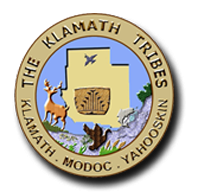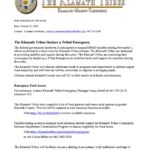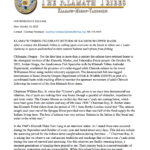FOR IMMEDIATE RELEASE
Date: October 10, 2025
Contact: Courtney Neubauer, courtney.neubauer@klamathtribes.org; 541.576.4458
KLAMATH TRIBES CELEBRATE RETURN OF SALMON IN UPPER BASIN
After a century the Klamath Tribes is calling upon everyone in the basin to allow our c’yaals (salmon) to spawn undisturbed in their natural habitat and refrain from fishing
Chiloquin, Oregon – For the first time in more than a century the salmon have returned home to the aboriginal territory of the Klamath, Modoc, and Yahooskin Paiute people. On October 10, 2025, Jordan Ortega, the Anadromous Fish Specialist with the Klamath Tribes Ambodat Department, confirmed the presence of a radio-tagged adult Chinook salmon in the lower Williamson River using mobile telemetry equipment. The documented fish was tagged downstream of Keno Dam by Oregon Department of Fish & Wildlife (ODFW) as part of a coordinated basin-wide tracking effort to monitor the upstream movement of adult Chinook following the removal of the four Klamath River dams.
Chairman William Ray, Jr. states that “Creator’s gifts, given to us since time immemorial our relatives, the ci’yaals are making their way home through a gauntlet of obstacles, impediments and toxic water. The Creator blesses us on this day that our c’yaals are coming home, which have been gone from our culture and way of life since 1909.” Chairman Ray, Jr. further states that Klamath Tribal elders from the period of 1911 from Berthe Lotches stated that “The salmon caught each year out of the Sprague River provided more than one-half of the food supply for the Indians living there. The loss of salmon was very serious. Salmon to the Indian is like bread and water to the white man.”
In the 1940’s Klamath Elder Tom Lang in an interview states: As I stated these runs occurred during the September and October of every year and lasted about sixty days. This did not include the spawning period for the Indians never caught salmon during that time….” Chairman Ray, Jr. is asking that we observe our oral ancient traditions and teachings that we leave our c’yaals alone during this time of renewal and spawning. Our fish relatives are finally returning home, a moment generations of maqlaqs have prayed to see. Their journey back is a sacred reminder of resilience, restoration and our responsibility. While this return brings deep joy we must remember these are not yet a fishable population. This is a time to honor their return by allowing them to spawn, rebuild, and restore the strength of their lineage. Let’s give them the time andprotection they need to thrive once again. They have come home. Now it’s our turn to take care of them.
The Klamath Tribes overriding goal is watershed restoration to produce cold, clean, drinkable ambo (water).
###
Courtney Neubauer, Interim Public Relations Director
courtney.neubauer@klamathtribes.org
541.576.4458
William E. Ray Jr., Klamath Tribes Chairman
wray.council@klamathtribes.com (541) 783-2219
About The Klamath Tribes
The Klamath Tribes’ primary mission is to “protect, preserve and enhance the spiritual, cultural and physical values and resources of the Klamath, Modoc and Yahooskin Peoples by maintaining the customs of our ancestors.” The heart of Tribal life is centered in Chiloquin, Oregon, and includes 12 Departments, Health Clinic, Childcare Center, Tribal Court, goos oLgi gowa Center, Research Station, and three tribal enterprises. The Klamath Tribes’ 12 departments facilitate service delivery to multiple aspects of tribal life, including health and fitness, education, economic development, social services, cultural preservation, natural resource protection, and more.



